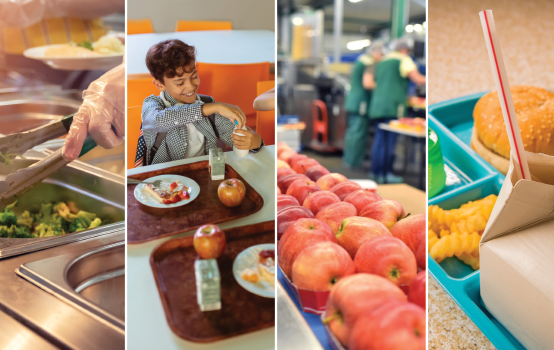Big corporations and food service companies are making millions of dollars from public school meal programs, often to the detriment of students and their health.
Since the 1970s, Big Food has colonized the school cafeteria. From signing lucrative food service contracts to promoting their corporate brands and dishing out chicken nuggets and other mass-produced, heat-and-serve items, the food industry has done quite well for itself by selling goods and services to schools across the United States, including the 95% of public schools that participate in the government-subsidized National School Lunch Program (NSLP).
In recent years, Big Food companies — and their industry associations — have spent millions of dollars lobbying the federal government to weaken or change its nutritional standards, and these efforts have paid off handsomely. It happened in 2014, when the U.S. Department of Agriculture (USDA) caved to industry pressure and made it easier for schools to serve French fries and pizza. It happened in 2018, when the USDA loosened restrictions on the amount of sodium, flavored milk, and refined grains that could be served in school meals. And it is happening again with the Trump administration’s latest proposal to make the rules more “flexible” (as Thompson, 2020, recently described in these pages).
At the same time, a fast-growing national movement has emerged in support of scratch cooking and the serving of local food in school cafeterias, led by the 42% of districts with active farm-to-school programs. As of the most recent farm-to-school census, in 2015, cafeterias adopting this model had redirected $789 million of public funding away from Big Food companies and into local food and farm economies. This movement seeks to reclaim power from Big Food while also engaging K-12 students in agriculture- and garden-based experiences in which they learn about the food they eat and where it comes from.
Yet, schools participating in the NSLP often struggle to break away from Big Food, for reasons both economic and cultural. Chief among them is a specious argument often wielded by those who want to maintain the status quo: Since cafeterias are not classrooms, they should not receive state and local tax dollars that are meant to go to instruction in academic subjects like math and English. (But if that reasoning were valid, shouldn’t it also apply to the funding of school athletics, theatrical productions, field trips, and other non-classroom activities?) Further, public education has never resolved its long-standing debate about whose responsibility it is to feed students during the school day: Given that the government requires children to attend school, shouldn’t it provide them (especially needy children) with meals, or is that a core responsibility of parents and other family members?
Facing ideological opposition from those who insist that food has nothing to do with education — and even if it does, that the government has little responsibility to provide it — many school districts are under enormous pressure to cut the cost of their lunch and breakfast programs, no matter how much it hurts their students, cafeteria workers, and communities.
School food finance 101
Schools participating in the USDA’s federal meal programs are generally expected to operate their breakfast and lunch service as a financially self-sustaining not-for-profit “business” (Gaddis, 2019). That has never been easy, though, and after feeding millions of children amid COVID-19 school closures, many food service programs across the country are now facing even deeper deficits than usual. As Spencer Taylor, the school nutrition director of Metro Nashville Public Schools told a reporter from Civil Eats, “COVID has wreaked havoc on our reserve balances, and we’re generating a fraction of the income” (Held, 2020).
To cover the cost of food, labor, operations, and other expenses, schools participating in the NSLP have two primary sources of revenue: 1) federal reimbursements for all qualifying meals, and 2) student payments for meals and à la carte items. Some school districts receive additional funding from their state government or local school board, but most state and local funding goes to general education budgets. Thus, it is the federal government that provides the vast majority of the dollars used to pay for the free, reduced-price, and partially reimbursed meals that roughly 30 million American children eat every school day.
The cost of producing and serving school meals depends on a range of local variables, such as school size, average daily participation rates, and local labor markets and food prices. But in most districts, the federal reimbursement rate has always been far too low to cover actual expenses. According to the USDA’s School Nutrition and Meal Cost Study, it cost schools an average of $3.81 to produce each lunch served through the NSLP during the 2014-15 school year, but the federal free lunch reimbursement rate was only $3.32. Breakfast was even more of a money pit: It cost schools an average of $2.72 to produce each breakfast served through the National School Breakfast Program (NSBP), but the reimbursement rate was just $1.88.
How do school food service directors close this budget gap? To cut expenses, they serve the cheapest and easiest-to-prepare (which usually means least healthy) foods they can find, while still meeting federal, state, and local nutrition standards. Many also try to reduce labor costs, either by outsourcing the preparation of meals to faraway factories or outsourcing the entire operation to a food service management company (FSMC).
Even then, many programs can’t make ends meet, so in addition to cutting costs, they also look for ways to increase revenue. Mainly, this means trying to entice children (including the roughly 20 million students who opt out of the NSLP, even though they’re eligible, and the millions more who opt out of the smaller NSBP) to use their own money (some of which the government may reimburse) to purchase school meals or à la carte items. To boost these sales, schools commonly introduce branded food items and “on-trend” concepts from popular fast-casual restaurant chains, exacerbating the commercialization of the school food environment and sharpening existing race- and class-based divisions in the cafeteria.
For the 2020-21 school year, the USDA increased the maximum federal reimbursement rate (for the 48 contiguous states) to $3.75 for a free lunch, $3.35 for a reduced-price lunch, and $0.48 for a paid lunch. That’s progress, but it doesn’t go nearly far enough. Without a major policy change (such as a shift to universal free school meals), school food service programs will continue to rely on heat-and-serve foods to reduce labor costs and à la carte sales to boost revenue. And given the economic losses they’ve suffered due to COVID-19 closures, many school boards will be tempted to turn their cafeterias over to a private company.
Hidden costs
Outsourcing K-12 food service programs to private management companies has a controversial history. For decades, the practice was outlawed: When the National School Lunch Act was passed in 1946, school food program directors — many of them trained in home economics or dietetics—persuaded Congress that for-profit operators had no place in the not-for-profit world of the federal lunch program. From survey research conducted in the 1920s and 1930s, they knew that commercial vendors tended to encourage children to purchase sugary and salty items (e.g., candies, cakes, soda pop, and pickles) because these unhealthy items were more profitable to sell.
A fast-growing national movement has emerged in support of scratch cooking and the serving of local food in school cafeterias.
In the late 1960s, however, millions of poor students became eligible for free school lunch, which meant that district administrators, particularly in large urban systems, faced a sudden demand to scale up their school meal programs. Lacking resources to build new kitchen and cafeteria facilities, many of them looked to the private sector for solutions. Facing intense pressure also from the National Restaurant Association, a powerful trade lobby representing the food service industry (and often referred to by food justice advocates as “the other NRA”), the USDA then decided, in 1970, to lift its restriction on for-profit providers.
The commercialization of the school lunch program ramped up quickly over the subsequent years. For districts looking for a quick and cheap way to feed lots of students, the easiest option was to outsource the daily work of preparing meals to a frozen food manufacturer and/or to hire a FSMC to run the lunch program, freeing the schools from the administrative burden.
During the 1980s, the Reagan administration pushed schools even further down this path by slashing the federal school lunch program’s budget by 25%. Since then, it has only become more and more common for districts to turn their cafeterias over to private corporations such as Aramark, Chartwells, and Sodexo (the “big three” FSMCs), in the hope that this will allow their food service departments to break even. During the 1987-88 school year, reported the USDA, only about 1 in 25 school districts relied on such companies, but outsourcing has grown rapidly since then, continuing to do so even in the 1990s and early 2000s, when FSMCs came under intense scrutiny for their dubious business practices. By 2014-15, according to the USDA’s School Nutrition and Meal Cost Study, one in five districts outsourced their meal programs.
In general, providing meals to students in K-12 education tends to be less profitable than contracting to institutions such as colleges and universities, which are subject to fewer regulations and allow vendors to charge significantly higher prices. Still, though, school contracts can be lucrative, particularly in very large urban districts with high free and reduced-price meal eligibility rates. This, along with regional variations in labor costs, helps to explain why the outsourcing of school meals is quite common in some parts of the country but practically nonexistent in others.
School districts in the Southeast are least likely (fewer than 1%) to outsource to FSMCs, while those in the Mid-Atlantic region are most likely (48%) to do so. Nationwide, just seven states (New York, New Jersey, Illinois, Ohio, Michigan, Pennsylvania, and Arizona) account for nearly 50% of all food service outsourcing in K-12 education — school officials in these states cite high labor costs involved in running their own cafeterias as the main reason for outsourcing (Jacobs & Graham-Squire, 2010). Still, despite regional variations, the effects of outsourcing have been felt everywhere. In the 50 years since the USDA opened the schoolhouse door to Big Food, the whole K-12 cafeteria sector — even in districts that don’t outsource — has seen a decline in labor standards and a dramatic increase in the sales and consumption of branded, prepackaged food products.
Cultivating consumers
Cafeterias’ heavy reliance on heat-and-serve items like chicken nuggets and pizza allows Big Food companies like Tyson and Kraft to reap large profits from the school lunch market (worth an estimated $20 billion per year). But these companies count on more than just the direct profits they make by selling their products to students. Just as important is the promise of additional and ongoing sales to consumers whose taste preferences and brand loyalties have been shaped in the school cafeteria. Young people spend a significant percentage of their disposable income on food and drinks, making them a key target for this industry. Annually, food and beverage companies spend more than $1.8 billion to promote their products to youth, roughly $140 million of which is spent on in-school marketing. According to research from the Rudd Center for Food Policy and Obesity, such marketing efforts are intentionally designed to encourage young people to become lifelong consumers of sugary beverages and fast food.
In 2004, the USDA mandated that by the 2006-07 school year, all districts in the country were to establish a local wellness policy to prevent the in-school marketing of unhealthy foods and drinks. As of the 2011-12 school year, however, researchers found that 70% of students in the elementary and middle grades still encountered such advertising at school (Harris & Fox, 2014), either because the wording of local policies was not strong and specific enough to deter marketers or because districts failed to implement their policies effectively (Harvey, Markenson, & Gibson, 2018). As a result, school continues to be one of the primary sites at which young people are exposed to branded fast-food items, which are served weekly in 30% of high schools and 10% of elementary schools (Terry-McElrath et al., 2014). And, of course, marketing occurs outside the cafeteria, too. For instance, teachers often hand out coupons for fast-food franchises as a reward for students’ good work. Companies set up rewards programs (e.g., General Mills’ Box Tops for Education) to incentivize students’ families to purchase their products. And students often encounter food and beverage advertisements on donated equipment and educational materials.
Branded foods are especially common in the à la carte offerings that “compete” with regular school lunches and breakfasts and which are designed to appeal to those students who do not qualify for free or reduced-price meals or who want to purchase food with their own money. For example, according to a USDA study of the food served in public, non-charter schools in 2014-15, 87% of schools offered branded foods for à la carte purchase during meal times, and vending machines were available in 30% of all schools (including 71% of high schools).
The Healthy, Hunger-Free Kids Act, passed by Congress in 2010, included a stipulation to improve the nutritional profile of these foods by the 2014-15 school year. This rule, known as “Smart Snacks in Schools,” places limits on the amount of fat, sugar, sodium, and calories of à la carte foods sold during the school day. In response, however, many Big Food manufacturers simply reformulated their products, creating Smart Snack-compliant versions of Doritos, Cheetos, Fruit by the Foot, and other popular items, using the same brand names and logos as the original, less-healthy items they continue to advertise and sell in stores. Thanks to these copycat snacks, they continue to rake in profits, but students are left confused as to whether these foods are healthy, and the overall nutritional environment of the school cafeteria suffers (Harris, Hyary, & Schwartz, 2016).
Taking back the school cafeteria
There is a better way to serve meals to children, but it requires schools to break their ties to food service companies and Big Food corporations.
In a 2011 New York Times opinion piece, reporter Lucy Komisar described what she called the “increasingly cozy alliance” between companies that manufacture processed foods and the FSMCs that prepare and sell those foods in school cafeterias. These businesses are “making students . . . fat and sick while pulling in hundreds of millions of dollars in profits,” she observed, citing research from the University of Michigan that found districts with privately managed cafeterias offered less healthy meals and made unhealthy snack items more widely available in schools. Further, the researchers found, many food service companies failed to deliver the economic savings they promised (Zullo, 2008). Compared to district-operated cafeterias, they spent less on food and labor, but they spent that much more on fees and supplies.
Districts with privately managed cafeterias offered less healthy meals and made unhealthy snack items more widely available in schools.
In those rare cases when private companies do run school meal programs at a lower cost (usually because they’ve replaced a district-operated program that was sorely mismanaged), they’ve done so mainly by exploiting their workers and securing kickbacks from food suppliers. For instance, while school-run cafeterias are staffed by district employees, FSMCs are able to hire hourly workers, paying them at lower rates and providing them with fewer benefits. A 2009 report on contracted food service workers in New Jersey’s K-12 public schools found that outsourced employees earned $4-$6 per hour less than those hired directly by districts (McCain, 2009). That’s the primary strategy by which these companies carve out their profits within the cash-strapped, not-for-profit world of public education.
Their other main strategy (used by large FSMCs, especially) is to leverage their bargaining power, obtaining rebates, discounts, and other benefits that make food prices lower than what an individual district would pay on its own. A union-funded 2010 study found that national FSMCs pay as much as 13% less for food than a typical district would pay for the same items. Further, FSMCs simply pocketed these cost savings until the 2009-10 school year (when the USDA required them to begin passing these savings on to school districts). They’ve compensated for this loss of extra revenue by increasing their management fees (MacDermott, 2010), or they’ve shifted more of their attention to less-regulated markets, such as university and college dining, where they can continue to seek these kickbacks (Apoliona-Brown et al., 2020).
Despite the shaky record of food service companies, parents and other community activists have long struggled to convince school board officials to bring food operations in-house (Stapleton, 2019). In recent years, advocacy groups have risen to the challenge, though. Earlier in 2020, for example, Real Food Generation (a nonprofit that seeks to leverage the power of youth and higher education institutions to shift money away from Big Food companies and toward real food economies) published a report that carefully documents the ways FSMCs manipulate prices for food and cafeteria supplies, both in the K-12 sector and in the food industry more broadly. Looking specifically at the “big three” companies (Aramark, Chartwells, and Sodexo), the report sheds much-needed light on how this secretive procurement system functions, how it harms communities, and how it reinforces the power of multinational corporations that have a terrible record of abusing food-chain workers and the environment (Apoliona-Brown et al., 2020).
Meanwhile, a number of other national nonprofits — including the Center for Good Food Purchasing, Urban School Food Alliance, Chef Ann Foundation, National Farm-to-School Network, and Food Corps — have organized efforts to improve school food procurement and preparation practices across the country. And in 2019, Sen. Bernie Sanders (I-VT) and Rep. Ilhan Omar (D-MN) introduced a congressional bill, the Universal School Meals Program Act, that would provide free meals to all students, increase the federal reimbursement rate for school meals, and create incentives for schools to serve locally produced food.
These are positive steps, and we should applaud such efforts to hold our government accountable. We can and should expect our public schools to serve students nutritious, eco-friendly, and culturally relevant meals and to provide good-quality jobs for food and farm workers. It’s past time to prioritize students, workers, and communities over the needs of Big Food corporations.
References
Apoliona-Brown, P., Dunn-Wilder, E., Guthrie, L., Robbins, P., Steel, A., & Strader, K. (2020). Be-trayed: How kickbacks in the cafeteria industry harm our communities — and what to do about it. Cambridge, MA: Real Food Generation.
Gaddis, J.E. (2019). The labor of lunch: Why we need real food and real jobs in American public schools. Berkeley, CA: University of California Press.
Harris, J.L. & Fox, T. (2014). Food and beverage marketing in schools: Putting student health at the head of the class. JAMA Pediatrics, 168 (3), 206-208.
Harris, J.L., Hyary, M., & Schwartz, M.B. (2016). Effects of offering look-alike products as smart snacks in schools. Childhood Obesity, 12 (6), 432-439.
Harvey, S.P., Markenson, D., & Gibson, C.A. (2018). Assessing school wellness policies and identifying priorities for action: Results of a bi-state evaluation. Journal of School Health, 88 (5), 359-369.
Held, L. (2020, June 29). As school meal programs go broke, a renewed call for universal free lunch. Civil Eats.
Jacobs, K. & Graham-Squire, D. (2010). Labor standards for school cafeteria workers, turnover and public program utilization. Berkeley Journal of. Employment and Labor Law, 31, 447.
Komisar, L. (2011, December 3). How the food industry eats your kid’s lunch. The New York Times.
MacDermott, T. (2010). Hard to swallow: Do private food service contractors shortchange New Jersey schools? Kinston, NH: Clarion Group.
McCain, M. (2009). Serving students: A survey of contracted food service work in New Jersey’s K-12 public schools. New Brunswick, NJ: Rutgers Center for Women and Work.
Stapleton, S.R. (2019). Parent activists versus the corporation: A fight for school food sovereignty. Agriculture and Human Values, 36 (4), 805-817.
Terry-McElrath, Y.M., Turner, L., Sandoval, A., Johnston, L.D., & Chaloupka, F.J. (2014). Commercialism in U.S. elementary and secondary school nutrition environments: Trends from 2007 to 2012. JAMA Pediatrics, 168 (3), 234-242.
Thompson, E. (2020). Why nutritious meals matter in school. Phi Delta Kappan, 102 (1), 34-37.
Zullo, R. (2008). Privatized school food service and student performance in Michigan: A preliminary report. Ann Arbor, MI: University of Michigan, Institute of Labor and Industrial Relations.
ABOUT THE AUTHOR

Jennifer E. Gaddis
JENNIFER E. GADDIS is an assistant professor of civil society and community studies at the University of Wisconsin-Madison. She is the author of The Labor of Lunch: Why We Need Real Food and Real Jobs in American Public Schools .










